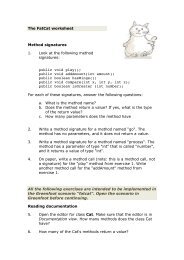SCIENCE TEST
SCIENCE TEST
SCIENCE TEST
Create successful ePaper yourself
Turn your PDF publications into a flip-book with our unique Google optimized e-Paper software.
of 4 of the large<br />
ng lactose broth<br />
t tubes (all concubated<br />
at 37°C<br />
es were examas<br />
yellow. If no<br />
red. If CO 2 was<br />
the top of the<br />
e broth<br />
CO 2<br />
−<br />
+<br />
−<br />
− −<br />
28. In Experiment 1, which of the bacterial species fermented<br />
lactose?<br />
For a F. sugar Species to be B fermented, only it must produce acid alone, or acid and CO2. Under the<br />
G. Species C only<br />
heading H. Species “Lactose B and broth” Species in Table D only1,<br />
we see that acid and CO2 were produced by species<br />
B, and J. acid Species alone C and was Species produced D only by species D.<br />
29. 29. Suppose Suppose that that in Experiment in Experiment 2 both 2 Species both B Species and Species B and C had been added to a large test tube<br />
Species C had been added to a large test tube contain-<br />
containing<br />
ing sucrose<br />
sucrose<br />
broth<br />
broth and<br />
and<br />
to<br />
to<br />
a large<br />
a large<br />
test<br />
test<br />
tube<br />
tube<br />
containing<br />
containing<br />
lactose broth. Which of the following would<br />
most likely lactose depict broth. the results? Which of the following would most<br />
likely depict the results?<br />
Answer: C.<br />
GO ON TO THE NEXT PAGE.<br />
52<br />
Comparing Table 1 and Table 2, we see that when two species are combined, they<br />
perform the fermentation they can do on their own plus any synergistic fermentation. For<br />
example, from Table 1 we see that species C ferments sucrose by producing both acid<br />
and CO2, and species D ferments lactose by producing both acid and CO2. In Table 2, we<br />
see that together they ferment both sucrose and lactose by producing both acid and CO2. There is a similar relationship between B and C, so we expect a similar result.<br />
30. Suppose a scientist isolates a bacterial species that is 1 of the 4 species used in Experiment 1. She adds<br />
the species to sucrose broth and observes that neither acid nor CO2 is produced. She then adds the species<br />
to lactose broth and observes that both acid and CO2 are produced. Based on the results of Experiment 1,<br />
the species is most likely:<br />
F. Species A.<br />
G. Species B.<br />
H. Species C.<br />
J. Species D.<br />
Answer: G.<br />
Sucrose broth Lactose broth<br />
acid CO 2 acid CO 2<br />
A. – – + +<br />
B. + + – –<br />
C. + + + +<br />
D. – – – –<br />
From Table 1, we see that there are three species that produce neither acid nor CO 2 in a<br />
sucrose broth when they are alone in the broth: species A, species B and species D. Of<br />
these, only species B produces both acid and CO 2 in a lactose broth.<br />
31. What is the evidence from Experiments 1 and 2 that Species C and Species D acted synergistically in<br />
Experiment 2?<br />
A. No acid was produced when each species was alone in the sucrose broth, but acid was produced<br />
when the 2 species were together in the sucrose broth.<br />
B. No acid was produced when each species was alone in the lactose broth, but acid was produced<br />
when the 2 species were together in the sucrose broth.<br />
C. No CO2 was produced when each species was alone in the sucrose broth, but CO2 was produced<br />
when the 2 species were together in the sucrose broth.<br />
D. No CO2 was produced when each species was alone in the lactose broth, but CO2 was produced<br />
when the 2 species were together in the lactose broth.



